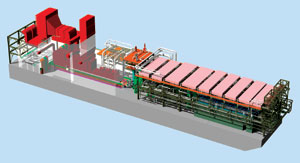 |
Italy |
|
Ultra high pressure sour gas injection on barge
The Kashagan oil field in the North Caspian Sea, off the coast of Kazakhstan, with recoverable reserves of up to 13 billion barrels, is one of the largest fields discovered over the last 30 years. The field will be developed by The North Caspian Sea Joint Venture formed by major oil companies: Agip, Eni affiliate acting as operator, British Gas, ExxonMobil, Shell, Total, ConocoPhillips and Inpex.
The Kashagan development program will be implemented in multiple phases: in the first, on-going phase, production will reach 75,000 bpd in 2008 to gradually increase to 450,000 bpd. Following later stages, oil production will increase to 1,200,000 bpd.
Offshore facilities for raw and inert gas injection in the reservoir will be built to maximize oil recovery and reduce sulfur production. Due to high reservoir pressure and presence of high percentages of H2S (around 20%) in the associated gas, the technologies adopted in Kashagan are among the most advanced in the world. Associated sour gas will be injected back into the oil reservoir at 760 bar (11,020 psi), the highest discharge pressure ever developed for gas injection.
Early last year, Agip KCO awarded GE Energy Oil & Gas (GE) a turnkey contract to supply the ultra high-pressure, sour gas re-injection system as a compression station entirely installed on barges, a real floating plant. Since then, GE has been engaged with full responsibility in design, procurement, fabrication and testing in Italy, of two complete Raw Gas Injection (RGI) barges. After sail-away, the barges will be transported to a Caspian Sea harbor for reinstatement of equipment, and eventually will reach their final destination at Kashagan field, some 60 km offshore.
 |
Concept for two barges under construction for sour gas re-injection in offshore Kashagan field.
|
|
New technology application. The project will leverage on the latest GE technology for gas injection applications: the two turbo-compression lines, each designed to inject 5.4 MMscm/d of sour gas, will be manufactured at GE’s facilities in Florence. The three-stage/ three-case gas centrifugal compressors are being specifically developed for this project along with the mechanical drivers, the GE Frame 5D double-shaft heavy-duty gas turbines with high reliability/ availability as required for high-pressure applications.
From the turbo-compression line composition, the project represents the technological consolidation of the previous two ultra-high re-injection pressure projects GE developed in the Kazakhstan area during the last six years. While the Kashagan contract, dated 2004, marks the start of the execution phase, since 2001, Agip KCO involved GE to develop the project feasibility study and conceptual design.
The project is now in the detailed design development phase and barge fabrication activities are already started. The twin barges, each having an overall estimated weight of 3,500+ tons and dimensions of 95-m length by 16-m width by 24-m height, complete with plant topside facilities, will be ready for shipment from an Italian port on September 2006.
Engineering and procurement. The entire design of the gas re-injection systems, i.e., mechanical, electrical instrument and control, is performed in-house at GE headquarter’s facilities in Florence.
Crucial aspects in such leading edge applications range from dense phase fluid-dynamics because of the highly supercritical process, to materials’ characterization and selection due to the severe sour service, from H2S and CO2; and from the compressor’s mechanical aspects considering casing design pressure of 1,000+ bar (14,500 psi) to the huge health/ safety/ environmental (HSE) impacts because of high toxicity and blast risk operations of this site.
Complete engineering of the barges is formalized, fully implementing the most sophisticated automated design tools including the hulls’ structural models and plant 3D model. In addition to GE’s OEM – i.e., turbo-compressors, interstage gas air-coolers, antisurge valves, and reciprocating compressors working as boosters for dry gas seals – the procurement scope of supply is encompassing essentially all of the balance of the plants’ equipment and materials.
The turbocompression trains, the GE Frame 5D gas turbines DLE version (30 MW ISO conditions) used as compressor mechanical drives, are equipped with Dry Low NOx systems for emissions control, and include all auxiliaries systems such as fuel gas, lube and starting, inlet air and exhaust systems, three-points baseplate and the acoustical enclosure.
Three stages/ three cases centrifugal compressors are the well-established Nuovo Pignone models BCL 404B + BCL 304C + BCL 304E with gearbox and load coupling. Each compressor is equipped with specifically designed dry gas seals and with a GE patented device for casing zero leakage assurance.
For the barges, GE is designing, procuring and supplying the two low-temperature, carbon-steel vessels. Each hull holds structurally integrated topside buildings to house machinery and control/ electrical equipment. Both barges’ hulls and buildings and main topside metallic structures are designed as blast-resistant to withstand to a design load of 3,000 kg/m2. Barge design and construction will be DNV 1A1 R0 marine certified. 
|




